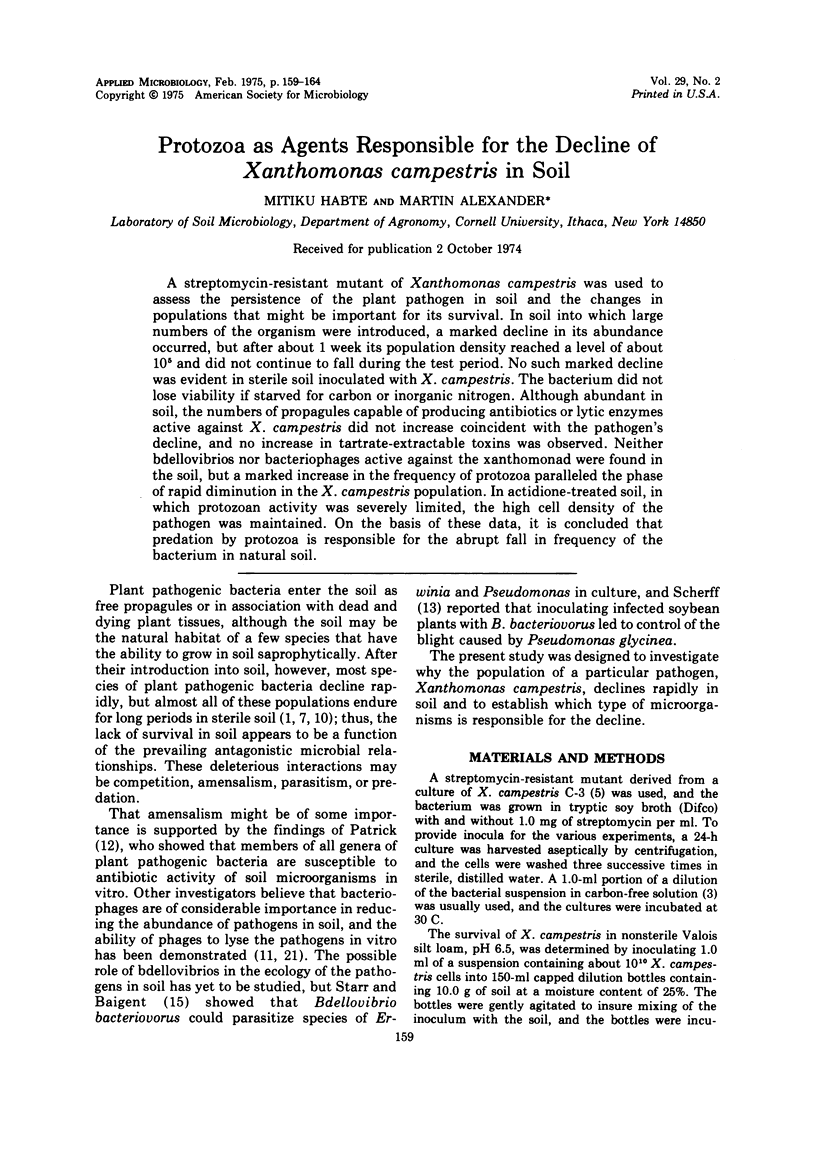Abstract
A streptomycin-resistant mutant of Xanthomonas campestris was used to assess the persistence of the plant pathogen in soil and the changes in populations that might be important for its survival. In soil into which large numbers of the organism were introduced, a marked decline in its abundance occurred, but after about 1 week its population density reached a level of about 105 and did not continue to fall during the test period. No such marked decline was evident in sterile soil inoculated with X. campestris. The bacterium did not lose viability if starved for carbon or inorganic nitrogen. Although abundant in soil, the numbers of propagules capable of producing antibiotics or lytic enzymes active against X. campestris did not increase coincident with the pathogen's decline, and no increase in tartrate-extractable toxins was observed. Neither bdellovibrios nor bacteriophages active against the xanthomonad were found in the soil, but a marked increase in the frequency of protozoa paralleled the phase of rapid diminution in the X. campestris population. In actidione-treated soil, in which protozoan activity was severely limited, the high cell density of the pathogen was maintained. On the basis of these data, it is concluded that predation by protozoa is responsible for the abrupt fall in frequency of the bacterium in natural soil.
Full text
PDF





Selected References
These references are in PubMed. This may not be the complete list of references from this article.
- COCHRAN W. G. Estimation of bacterial densities by means of the "most probable number". Biometrics. 1950 Jun;6(2):105–116. [PubMed] [Google Scholar]
- COOK F. D., QUADLING C. A modified technique for isolation of bacteriophage from contaminated materials. Can J Microbiol. 1959 Jun;5(3):311–312. doi: 10.1139/m59-037. [DOI] [PubMed] [Google Scholar]
- Danso S. K., Habte M., Alexander M. Estimating the density of individual bacterial populations introduced into natural ecosytems. Can J Microbiol. 1973 Nov;19(11):1450–1451. doi: 10.1139/m73-234. [DOI] [PubMed] [Google Scholar]
- Ensign J. C. Long-term starvation survival of rod and spherical cells of Arthrobacter crystallopoietes. J Bacteriol. 1970 Sep;103(3):569–577. doi: 10.1128/jb.103.3.569-577.1970. [DOI] [PMC free article] [PubMed] [Google Scholar]
- STOLP H., STARR M. P. BDELLOVIBRIO BACTERIOVORUS GEN. ET SP. N., A PREDATORY, ECTOPARASITIC, AND BACTERIOLYTIC MICROORGANISM. Antonie Van Leeuwenhoek. 1963;29:217–248. doi: 10.1007/BF02046064. [DOI] [PubMed] [Google Scholar]
- Starr M. P., Baigent N. L. Parasitic interaction of Bdellovibrio bacteriovorus with other bacteria. J Bacteriol. 1966 May;91(5):2006–2017. doi: 10.1128/jb.91.5.2006-2017.1966. [DOI] [PMC free article] [PubMed] [Google Scholar]
- Stokes J. L., Parson W. L. Role of poly-beta-hydroxybutyrate in survival of Sphaerotilus discophorus during starvation. Can J Microbiol. 1968 Jul;14(7):785–789. doi: 10.1139/m68-130. [DOI] [PubMed] [Google Scholar]
- Van Donsel D. J., Geldreich E. E., Clarke N. A. Seasonal Variations in Survival of Indicator Bacteria in Soil and Their Contribution to Storm-water Pollution. Appl Microbiol. 1967 Nov;15(6):1362–1370. doi: 10.1128/am.15.6.1362-1370.1967. [DOI] [PMC free article] [PubMed] [Google Scholar]
- Webley D. M., Follett E. A., Taylor I. F. A comparison of the lytic action of Cytophaga johnsonii on a eubacterium and a yeast. Antonie Van Leeuwenhoek. 1967;33(2):159–165. doi: 10.1007/BF02045546. [DOI] [PubMed] [Google Scholar]
- Welsch M. Bacteriostatic and Bacteriolytic Properties of Actinomycetes. J Bacteriol. 1942 Nov;44(5):571–588. doi: 10.1128/jb.44.5.571-588.1942. [DOI] [PMC free article] [PubMed] [Google Scholar]


